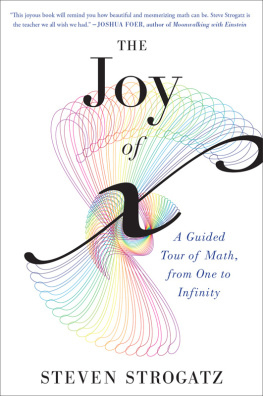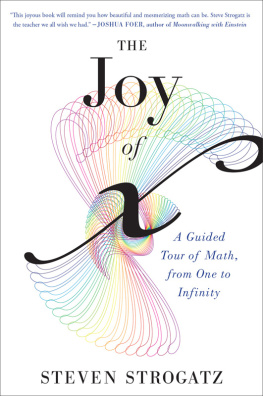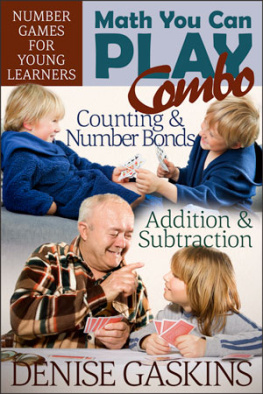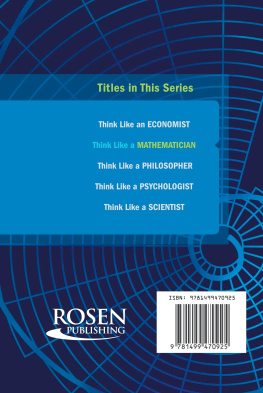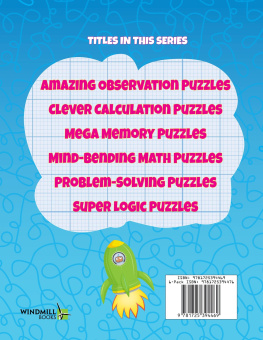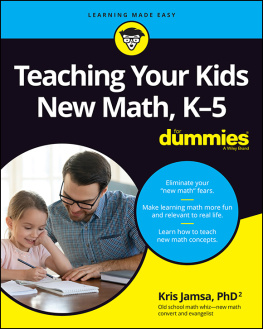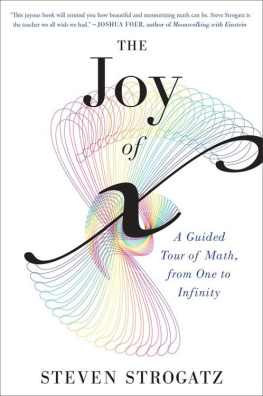
Table of Contents
Copyright 2012 by Steven Strogatz
All rights reserved
For information about permission to reproduce selections from this book, write to Permissions, Houghton Mifflin Harcourt Publishing Company, 215 Park Avenue South, New York, New York 10003.
www.hmhbooks.com
The Library of Congress has cataloged the print edition as follows:
Strogatz, Steven H. (Steven Henry)
The joy of x : a guided tour of math, from one to infinity / Steven Strogatz.
p. cm.
ISBN 978-0-547-51765-0 (hardback)
1. MathematicsPopular works. I. Title.
QA93.S77 2012
510dc23 2012017320
Illustrations by Margaret Nelson
eISBN 978-0-547-51766-7
v1.1012
Chapters are adapted, with permission, from pieces originally published in the New York Times.
Grateful acknowledgment is made for permission to reprint an excerpt from the following copyrighted work: , from p. 111 of The Solitude of Prime Numbers: A Novel by Paolo Giordano, translated by Shaun Whiteside, copyright 2008 by Arnoldo Mondadori Editore S.p.A., translation copyright 2009 by Shaun Whiteside. Used by permission of Pamela Dorman Books, an imprint of Viking Penguin, a division of Penguin Group (USA) Inc.
Credits appear on .
Preface
I have a friend who gets a tremendous kick out of science, even though hes an artist. Whenever we get together all he wants to do is chat about the latest thing in psychology or quantum mechanics. But when it comes to math, he feels at sea, and it saddens him. The strange symbols keep him out. He says he doesnt even know how to pronounce them.
In fact, his alienation runs a lot deeper. Hes not sure what mathematicians do all day, or what they mean when they say a proof is elegant. Sometimes we joke that I should just sit him down and teach him everything, starting with 1 + 1 = 2 and going as far as we can.
Crazy as it sounds, thats what Ill be trying to do in this book. Its a guided tour through the elements of math, from preschool to grad school, for anyone out there whod like to have a second chance at the subjectbut this time from an adult perspective. Its not intended to be remedial. The goal is to give you a better feeling for what math is all about and why its so enthralling to those who get it.
Well discover how Michael Jordans dunks can help explain the fundamentals of calculus. Ill show you a simpleand mind-blowingway to understand that staple of geometry, the Pythagorean theorem. Well try to get to the bottom of some of lifes mysteries, big and small: Did O.J. do it? How should you flip your mattress to get the maximum wear out of it? How many people should you date before settling down? And well see why some infinities are bigger than others.
Math is everywhere, if you know where to look. Well spot sine waves in zebra stripes, hear echoes of Euclid in the Declaration of Independence, and recognize signs of negative numbers in the run-up to World War I. And well see how our lives today are being touched by new kinds of math, as we search for restaurants online and try to understandnot to mention survivethe frightening swings in the stock market.
By a coincidence that seems only fitting for a book about numbers, this one was born on the day I turned fifty. David Shipley, who was then the editor of the op-ed page for the New York Times, had invited me to lunch on the big day (unaware of its semicentennial significance) and asked if I would ever consider writing a series about math for his readers. I loved the thought of sharing the pleasures of math with an audience beyond my inquisitive artist friend.
The Elements of Math appeared online in late January 2010 and ran for fifteen weeks. In response, letters and comments poured in from readers of all ages. Many who wrote were students and teachers. Others were curious people who, for whatever reason, had fallen off the track somewhere in their math education but sensed they were missing something worthwhile and wanted to try again. Especially gratifying were the notes I received from parents thanking me for helping them explain math to their kids and, in the process, to themselves. Even my colleagues and fellow math aficionados seemed to enjoy the pieceswhen they werent suggesting improvements (or perhaps especially then!).
All in all, the experience convinced me that theres a profound but little-recognized hunger for math among the general public. Despite everything we hear about math phobia, many people want to understand the subject a little better. And once they do, they find it addictive.
The Joy of x is an introduction to maths most compelling and far-reaching ideas. The chapterssome from the original Times seriesare bite-size and largely independent, so feel free to snack wherever you like. If you want to wade deeper into anything, the notes at the end of the book provide additional details and suggestions for further reading.
For the benefit of readers who prefer a step-by-step approach, Ive arranged the material into six main parts, following the lines of the traditional curriculum.
Part 1, Numbers, begins our journey with kindergarten and grade-school arithmetic, stressing how helpful numbers can be and how uncannily effective they are at describing the world.
Part 2, Relationships, generalizes from working with numbers to working with relationships between numbers. These are the ideas at the heart of algebra. What makes them so crucial is that they provide the first tools for describing how one thing affects another, through cause and effect, supply and demand, dose and response, and so onthe kinds of relationships that make the world complicated and rich.
Part 3, Shapes, turns from numbers and symbols to shapes and spacethe province of geometry and trigonometry. Along with characterizing all things visual, these subjects raise math to new levels of rigor through logic and proof.
In part 4, Change, we come to calculus, the most penetrating and fruitful branch of math. Calculus made it possible to predict the motions of the planets, the rhythm of the tides, and virtually every other form of continuous change in the universe and ourselves. A supporting theme in this part is the role of infinity. The domestication of infinity was the breakthrough that made calculus work. By harnessing the awesome power of the infinite, calculus could finally solve many long-standing problems that had defied the ancients, and that ultimately led to the scientific revolution and the modern world.
Part 5, Data, deals with probability, statistics, networks, and data mining, all relatively young subjects inspired by the messy side of life: chance and luck, uncertainty, risk, volatility, randomness, interconnectivity. With the right kinds of math, and the right kinds of data, well see how to pull meaning from the maelstrom.
As we near the end of our journey in part 6, Frontiers, we approach the edge of mathematical knowledge, the borderland between whats known and what remains elusive. The sequence of chapters follows the familiar structure weve used throughoutnumbers, relationships, shapes, change, and infinitybut each of these topics is now revisited more deeply, and in its modern incarnation.
I hope that all of the ideas ahead will provide joyand a good number of Aha! moments. But any journey needs to begin at the beginning, so lets start with the simple, magical act of counting.
Part One
NUMBERS
1. From Fish to Infinity
T HE BEST INTRODUCTION to numbers Ive ever seenthe clearest and funniest explanation of what they are and why we need themappears in a
Next page

